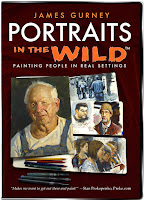John Singer Sargent was a favorite target for cartoonists.
 |
| Max Beerbohm (1907) & Sir John Bernard Partridge (1925). |
The one on the left satirizes the way he created a refined environment by bringing musicians into the studio to make his subjects feel like royalty. On the right we see him jab at the canvas like a fencer.
Sargent's paintings themselves were also targets. From left, the Mephisto-esque gaze of the Carolus-Duran portrait; the Boit daughters estranged in big spaces among oversize vases; and Madame X with her heart shaped bodice and dull face.
Here we see good friends Velazquez and Sargent convey their paintings to the National Collection. Liz Renes says:
"In a Punch cartoon from 1906, Sargent is seen carrying his portrait of Ellen Terry as Lady MacBeth while walking hand in hand with Velazquez, who also carries the Rokeby Venus. Both march boldly into the National Gallery, where their works would stand in perpetuity with the likes of Reynolds, Gainsborough and Turner. The cartoon makes no distinction between the fact that the Venus was bought for the nation through the National Art Collections Fund, while Lady Macbeth was donated by Sir Joseph Duveen. Indeed, the source of the works appears irrelevant to the fact that these two illustrious additions to the national collection came from 'desirable aliens', or painters who were not British. So while Sargent seemingly has reached the same stature as the great Old Master - unlike the criticism in the press early in his career, which implied him to be a type of Velasquez 'pretender' - he is still ostracised for his American parentage. Sargent's 'nation', as implied by the 'alien' epithet in this cartoon, was an often contestable aspect of his career as a painter. British, French, American - even to this day, art historians and critics struggle with how to accurately define and place an artist like Sargent, even though he remains revered and hallowed in the canon."
Read the rest: Sargentology: Praise by Exaggeration







































